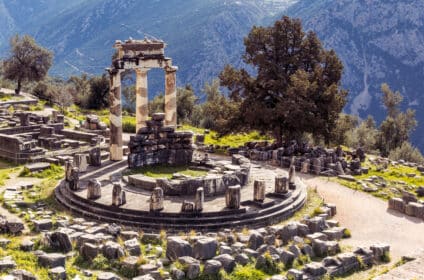- Viewed - 545
Description
At the foot of Mount Parnassos, within the angle formed by the twin rocks of the Phaedriades, lies the Pan-Hellenic sanctuary of Delphi, which had the most famous oracle of ancient Greece. Delphi was regarded as the centre of the world. According to mythology, it is here that the two eagles sent out by Zeus from the ends of the universe to find the navel of the world met. The sanctuary of Delphi, set within a most spectacular landscape, was for many centuries the cultural and religious centre and symbol of unity for the Hellenic world. The history of Delphi begins in prehistory and in the myths of the ancient Greeks. In the beginning the site was sacred to Mother Earth and was guarded by the terrible serpent Python, who was later killed by Apollo. Apollo’s sanctuary was built here by Cretans who arrived at Kirrha, the port of Delphi, accompanied by the god in the form of a dolphin. This myth survived in plays presented during the various Delphic festivals, such as the Septerion, the Delphinia, the Thargelia, the Theophania and, of course. the famous Pythia, which celebrated the death of Python and comprised musical and athletic competitions.
The archaeological site of Delphi includes two sanctuaries, dedicated to Apollo and Athena, and other buildings, mostly intended for sports. Visitors arriving from Athens first encountered the sanctuary of Athena Pronaia – that is, ?Athena who is before the temple? (of Apollo). Outside its walls spread the settlement of Delphi. Within the walls were the famous Tholos, the symbol of Delphi today, and the remains of three temples dedicated to the goddess. The two earlier temples were built of tufa on the same location. These date to the middle of the seventh century and to c. 500 BC. The third temple, made of limestone, was built at the west end of the sanctuary after the earthquake of 373 BC. This sanctuary also includes the altars of Zeus Polieus, Athena Ergane, Athena Zosteria, Eileithyia and Hygeia, the remains of two buildings dedicated to the cult of the local heroes Phylakos and Autono?s, who routed the Persians from Delphi, and two treasuries with marble roofs, one Doric and the other Aeolian. The Aeolian Treasury of Massalia preserves a characteristic palm-leaf capital. Finally, the sanctuary included a memorial to the routing of the Persians, a statue of Emperor Hadrian, and a building known as the ?house of the priests
Administrative Information:
Ephorate of Antiquities of the Prefecture of Fokida
Τ.Κ. 33054, Delphi (Prefecture of Fokida)
Telephone: +30 22650 82313, 82346
Fax: +30 22650 82966
Email: efafok@culture.gr
Tickets:
Full: €12, Reduced: €6
Museum & Archaeological Site
Amenities for the physically challenged:
The visit of the persons with reduced mobility with the special vehicle in the Archaeological Site to the Temple of Apollo, will be available after informing the Ephorate (tel.: 22650 82312 e-mail: efafok@culture.gr) at least 7 days prior to the arrival.
Access:
www.ktel-fokidas.gr
Source: http://odysseus.culture.gr
Ephorate of Antiquities of the Prefecture of Fokida
Location / Contacts
- Address : Delphi
- Phone : +302265082313
- Mail : efafok@culture.gr
- Website : http://odysseus.culture.gr





